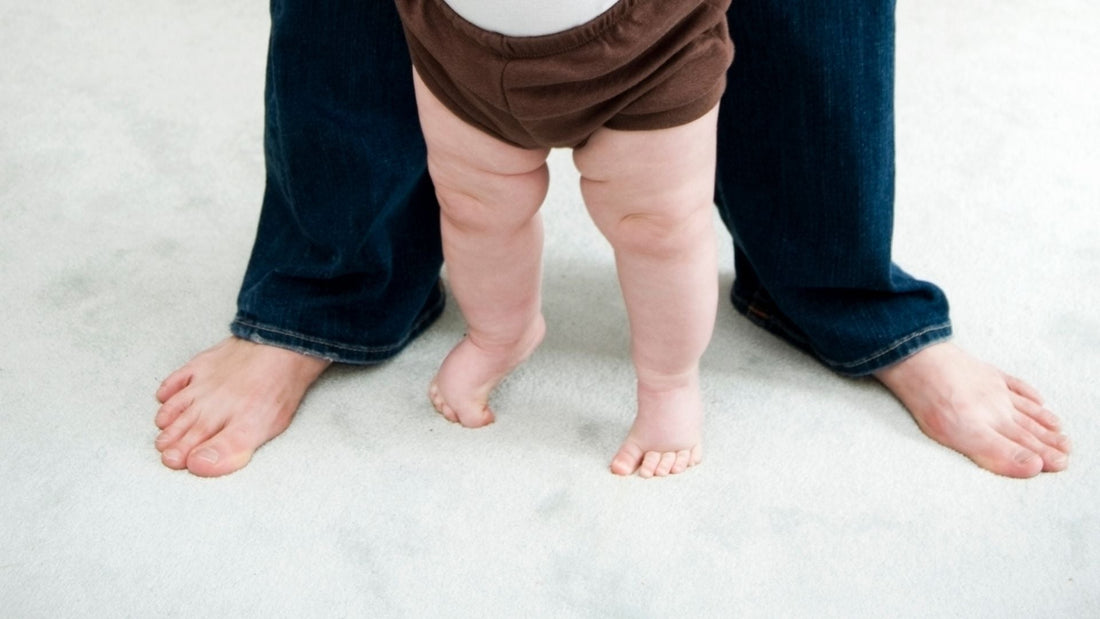Positional brachycephaly
Your puppy has now become a child who is preparing to discover the world at a walking pace. In fact, around the age of one he will begin to take his first steps towards walking independently.
Have you noticed that your baby walks on tiptoe and are wondering if it is normal? You can find the answer in this article!
How is the foot support during the first steps?
If the baby has been stimulated with the right activities from the first weeks, at the age of 8-11 months he will have already reached the crawling stage and will start to pull himself up using supports.
This is your baby's first real foot support and it is important that the little one has full proprioception through bare feet or a non-slip sock. For this reason, in the article on first steps shoes I advise against having them wear them at home.
In fact, it is precisely on the basis of the quality of the foot support and the increase in safety that the little one will begin to take his first steps independently .
The child walks on tiptoe during the first supports
When the child begins to pull himself up using supports such as the sofa, furniture or chairs, it is very common for him to stand on tiptoe . Usually this position is alternated with full plantar support .
Although it is good to keep an eye on your support and spinal posture, most of the time, this is a normal and temporary process .

Why is this normal?
Now I'll explain why it's considered normal for a child to walk on tiptoe during his first steps.
The muscles of the foot and calf are activated to give stability to the ankle and lower limbs. Therefore, especially during the push phase, the child stands on tiptoe.
It follows that even in the first lateral steps it will be common to notice that he initially moves on tiptoe and the same goes for the first front steps.
This phase will gradually be abandoned when the child begins to walk independently.

The child walks on tiptoes even after 16 months
We have seen that the child walks on tiptoe until he begins to take his first steps independently .
But what if it continues afterwards?
If your little one used a walker or lightweight stroller to learn to walk, he or she may continue to walk on tiptoe for a longer period of time.
After 16 months , however, it would be advisable to point this out to the pediatrician who will check that the child does not position his feet internally or externally rotated or that he has incorrect positions.
If necessary, the latter will advise the parents to consider a visit to the Osteopath who will check the lower limbs and the plantar support. In the video below you can see an evaluation visit.
The Osteopath's intervention for the lower limbs
The Osteopath checks the muscles of the foot and calf , responsible for the flexion of the foot, to understand if there are contractures . In fact, these force the child to assume an incorrect position and plantar support.
It is important to intervene as early as possible to prevent the child from getting used to walking on tiptoe.
After an initial assessment, in case of contractures, treatments will be performed to relax the muscles of the foot and leg . In this way, full and conscious plantar support will be promoted.
If the problem persists, it will be necessary to investigate the situation further with a specialist doctor or an orthopedist.
Child walks on tiptoe: serious cases
As we have said, most of the time the child walks on tiptoes only for a temporary period and without specific causes . In this case, toe walking is defined as idiopathic .
However, there are cases, fortunately rare, in which the child walks on tiptoe due to serious problems.
This category includes:
- Forms of autism : often also associated with relational or coordination delays;
- Neurological pathologies : in this case, there are also delays in psychomotor development;
- Equine foot : pathology in which the Achilles tendon is shorter and forces the child to rest only on the tip.
Equinus foot can be suspected when the child lands on one foot normally and stays on the tip of the other. In fact, this problem usually does not affect both feet.
Treatments for Equine Foot
Equine foot can be treated in different ways depending on the extent:
- Physiotherapist treatment to stretch the tendon;
- Braces or casts;
- Muscle injections;
- Surgery.

Toe Walking Tips
Although in most cases the child stops walking on tiptoe by himself, it is possible to adopt some measures to encourage the correct support of the foot :
- Leave the child barefoot at home or with only non-slip socks;
- Eliminate lightweight walkers and trolleys.
When the little one is about to take his first steps, it would be advisable to have the muscles and plantar support assessed by the Osteopath. In this way it will be possible to intervene immediately if there are contractures to promote autonomous walking and a correct posture of the little one. To book a visit to my office you can find my contacts by clicking here.
In addition, I recommend my video course Osteo massage where you can discover how to perform a lower limb massage for In the video course Osteo massage you can discover how to perform a lower limb massage on your child to support the development of the foot support, legs and posture of your child.

